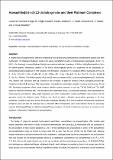Acenaphtho[5,6-cd]-1,2-dichalcogenoles and their platinum complexes
Abstract
A related series of bis(phosphine) platinum complexes 1–5 and 6–8 bearing dichalcogenate acenaphthylene ligands have been synthesised. The chalcogen–chalcogen bonds in the parent acenaphtho[5,6-cd]-1,2-dichalcogenoles (AcenapylE2; L1 E = S, L2 E = Se; Acenapyl = acenaphthylene-5,6-diyl) were reduced with two equivalents of lithium triethylborohydride to form the dilithio-species. Metathetical addition of the lithium dichalcogenate species to a suspension of the appropriate cis-dichlorobis(phosphine)platinum in THF resulted in the formation of platinum(II) complexes [Pt(5,6-AcenapylE2)(PR3)2] (1 E = S, R3 = Ph3; 2 E = S, R3 = Ph2Me; 3 E = S, R3 = PhMe2; 4 E = S, R3 = Me3; 6 E = Se, R3 = Ph3; 7 E = Se, R3 = Ph2Me; 8 E = Se, R3 = PhMe2). The dilithio-species of L1 and L2 were also reacted with (1,5-cyclooctadiene)platinum(II) dichloride. This reaction was successful with L1 resulting in the formation of platinum complex [Pt(5,6-AcenapylS2)(COD)] (5). Complexes 1–3 and 5–8 have been fully characterised, principally by multinuclear magnetic resonance spectroscopy, IR and MS. Secondary isotopomer effects create complex satellite systems observed in both the 31P{1H} NMR and 77Se NMR spectra of selenium complexes 6–8. X-ray structures were determined for L1, 1, 3 and 6 and analysed, where appropriate, by measuring the peri-distance, splay angle magnitude, peri-atom displacement, central naphthalene ring torsions and the geometry around the platinum centre. Platinum was found to adopt a distorted square-planar geometry in all three complexes. Complex 1 was found to have the greatest molecular distortion of all three complexes, showing that changing the phosphine group and also the chalcogen has a noticeable effect. Comparisons were made between 6 and our previously reported [Pt(NapSe2)(PPh3)2] and [Pt(AcenapSe2)(PPh3)2] complexes; the level of distortion was found to decrease as the backbone is altered from naphthalene to acenaphthylene.
Citation
Diamond , L , Knight , F R , Cordes , D B , Ward , A C C , Slawin , A M Z & Woollins , J D 2015 , ' Acenaphtho[5,6-cd]-1,2-dichalcogenoles and their platinum complexes ' , Polyhedron , vol. 85 , pp. 395-404 . https://doi.org/10.1016/j.poly.2014.08.046
Publication
Polyhedron
Status
Peer reviewed
ISSN
0277-5387Type
Journal article
Description
The work in this project was supported by the Engineering and Physical Sciences Research Council (EPSRC).Collections
Items in the St Andrews Research Repository are protected by copyright, with all rights reserved, unless otherwise indicated.

